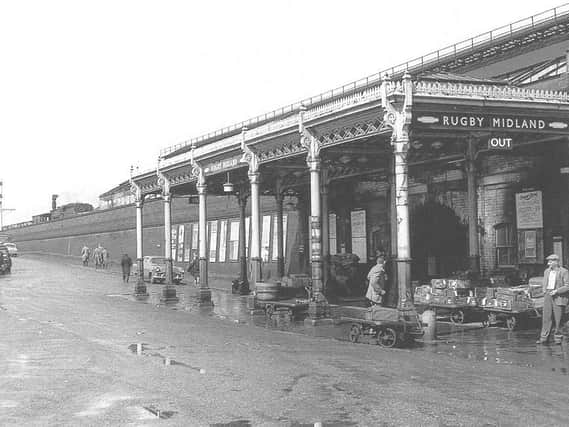Former Advertiser reporter remembers the Golden Age of Steam, when Rugby was a trainspotters' paradise


I’ll never forget the moment I first clapped eyes on them. There was I, on the pillion of my father’s NSU Prima scooter, having just travelled through the murky Mill Road tunnel and just turned right past Rugby Midland Station.
For here they were, lining that long blue brick wall like so many starlings on a telegraph wire… the Rugby trainspotters.
Advertisement
Hide AdAdvertisement
Hide AdI can see them now. Despite it being a school-free Saturday morning, this chain of small boys, each with notebook and pencils in their hands, all seemed to be wearing their school caps.
Ah yes. It was brown for Newbold High, cherry red for Dunsmore, dark blue for Lawrence Sheriff, light blue for Murray, and with the rest representing schools the names of which escape me.
In those days, Rugby was a trainspotter’s heaven on earth. Not only was it the setting for the greatest junction system in Britain, but it once also boasted the biggest gantry in the world.
Yes, I fully realise that I’m possibly on dangerous ground here, as there is bound to be an ‘anorak’ out there somewhere who knows different, but hey-ho, let’s take that risk. This is how I remember it.
Advertisement
Hide AdAdvertisement
Hide AdThe wall which ran along the track westwards from the ‘veranda’ entrance of Rugby Midland was not the only vantage point, though. I seem to recall that many spotters could in turn be ‘spotted’ themselves, near the English Electric factory buildings.
And the species could also be observed in their natural habitat around the vicinity of Lower Hillmorton Road, lying in ambush, just in case one of those queens of steam hissed and puffed its regal progress through Rugby Central.
I also seem to recall that there was a fence opposite where the spotters would gather. The plain fact was that to be born in Rugby, and therefore having a natural interest in locomotives, was a bit like having a taste for beer and living above a brewery.
Rugby’s link to the railways goes back to the great building era of the mid-19 th century. And there will still be many people in the town and elsewhere whose ancestors worked in the industry.
Advertisement
Hide AdAdvertisement
Hide AdMy lifelong friend Brian Meredith’s grandfather was a Rugby railwayman. And Brian himself could be said to have followed the family calling by working for Peco, a leading manufacturer of model railway accessories, and publishers of the hobby’s number one magazine.
One of my earliest memories is standing on the compost heap at the bottom of ‘Silksworth’, my grandparents’ house in Newbold Road, marvelling at the cotton wool clouds that burst forth like dragons’ breath out of the great, black leviathans as they puffed their way westwards.
There will also be quite a few people who might still remember the old Leicester line, one of the many that fell under the Beeching axe of 1963.
As a child, I would look out of my Churchover bedroom window at night and see the lights of train carriages, a luminescent snake gliding through the darkened, silent fields of north-east Warwickshire.
Advertisement
Hide AdAdvertisement
Hide AdOne day, in the late spring of 1963, I actually travelled a short distance in one of the last, carriage-less locos to travel the track.
In those days, I had a part-time labouring job at Joe and Deirdre Towers’ Harborough Fields farm, which was situated next to the line. Some sheep had gone missing, and Joe and I were searching for them along the track.
As we probed the scrub along the embankment – encountering several grass snakes, along the way as it happened – an engine drew up and shuddered to a halt.
The driver asked us what we were doing, and upon hearing of our quest, offered us a lift in the cab of his locomotive. This being a gloriously sunny day in May, the one thing that sticks in my memory was the intense heat in that cab, the coal-hungry fire and its insatiable desire for fuel heating our metal capsule to what was for me a thoroughly unbearable temperature.
Advertisement
Hide AdAdvertisement
Hide AdAfter about a mile or so, we spotted the missing animals. The driver obligingly halted his mighty machine, we thanked him, and then went our separate ways.
If the truth be known, I was never a trainspotter. But following our experience, I couldn’t help but think what those lads lining the wall outside Rugby Midland three miles down the track would have given to have been in my shoes on that sunny day in May as the great Age of Steam was slowly grinding to a halt.
John Phillpott’s book Go and Make the Tea, Boy! a memoir of his days as a reporter on the Rugby Advertiser, is published by Brewin Books and out now.